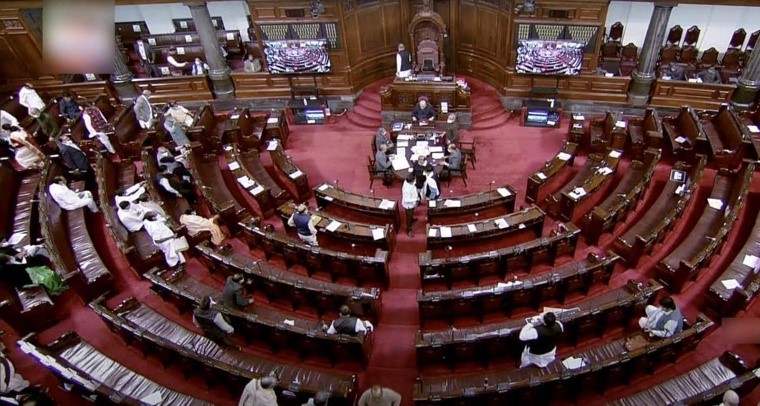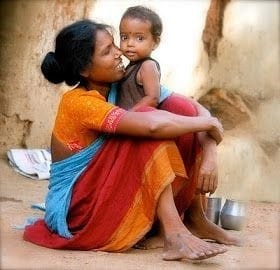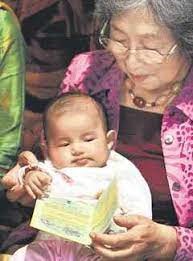Surrogacy Law in India: An Overview
why in news
Recently parliament has passed two Acts to regulate reproductive law/surrogacy in India. These Acts excluded live-in couples, single men and the LGBTQ (Lesbian, Gay, Bisexual, Transgender, Intersex and Queer) community to get a child by surrogacy. Some other important landmark changes also have been done through these laws. These changes trigger controversy on Indian law regulating surrogacy.
The law governing surrogacy in India
In December 2021, parliament has passed the following Act which replaced old Acts. These are:
- The Assisted Reproductive Technology (Regulation) Act, 2021 (in short ART Act)
- The Surrogacy (Regulation) Act, 2021
What is surrogacy?
Surrogacy is one of many Assisted Reproductive Technologies. The word Surrogacy denotes a process whereby a woman became a gestational carrier and bears a child for another person, who becomes the child’s parent/perents after birth.
What is commercial surrogacy?
Receiving money from the biological parents by the gestation carrier mother for surrogacy is known as commercial surrogacy.
The legality and cost of surrogacy vary widely from country to country. Because of the low cost of infertility clinics and the availability of poor women who is easily ready to bear a child for money, in recent years India has become a popular destination for commercial surrogacy.

What is Assisted Reproductive Technology (ART)?
ART is a common term for a medical procedure to treat infertility. This refers to techniques that seek to obtain a pregnancy by handling a gamete (sperm or egg) outside the human body and transferring the gamete or fertilised embryo into the woman’s uterus. These arrangements include in-Vitro fertilisation (fertilising an egg in the lab), gamete donation and surrogacy. ART procedures sometimes use donor eggs, donor sperm, or previously frozen embryos.
IVF (In Vitro Fertilization) is the most common and effective type of ART.
The Assisted Reproductive Technology (Regulation) Act, 2021 (ART Act)
Time frame:
- Introduced in Lok Sabha: September 14, 2020
- Standing committee report: March 19, 2021
- Passed by Lok Sabha: December 1, 2021
- Passed by Rajya Sabha: December 8, 2021
- Gazette notification: December 20, 2021
Background of the Act
2002: the Indian Council for Medical Research has given guidelines to regulate ARTs.
2005: The government approved the 2002 draft of the National Guidelines for the accreditation, supervision and Regulation of ART Clinics in India.
2008: The Indian Council of Medical Research (ICMR) was the first Bill to be drafted to regulate the ART industry in 2008.
2009: the Law Commission of India submitted the 228th report on Assisted Reproductive Technology procedures discussing the importance and need for surrogacy and also the steps that are taken to control surrogacy arrangements.
2013: surrogacy by foreign homosexual couples and single parents was banned. The Bill prohibited these categories of persons from surrogacy: couples already having one child, foreigners or Overseas Citizens of India (OCI), holders as well as live-in-Partners, single people, homosexuals and widows. There has been significant criticism of the Bill.
2015: the government banned commercial surrogacy in India and permitted entry of embryos only for research purposes. Although transnational surrogacy was banned in India in 2015, ART and domestic commercial surrogacy have continued to flourish with the help of entrenched networks of unvetted agents and private clinics.
2016: Surrogacy (Regulation) Bill was introduced and passed by Lok Sabha. This Bill was proposed to permit only heterosexual Indian couples married for at least five years with infertility problems to access altruistic or unpaid surrogacy. This bill has banned commercial surrogacy. This Bill lapsed owing to the adjournment sine die of the parliament session.
2019: The Bill was reintroduced and passed by the Lok Sabha.
2020: Reintroduced and sent to the standing committee.
Need for the Act to regulate serogacy

Need for standardising protocols
There are so many such ART clinics that have been running without regulation. It was necessary to regulate them in the interest of public health, national interest, friendly relations with foreign states, public order, decency and morality.
Need for the protection of women and children
The oocyte (a cell in an ovary) donor, carrier mother, and child born need to be supported with proper medical and financial assistance.
Main objectives
To regulate and supervise Assisted Reproductive Technology (ART) clinics. While presenting the Bill Health Minister Mansukh Mandaviya said in Parliament that the idea behind the new legislation is to “regulate” and “supervise” Assisted Reproductive Technology (ART) clinics and surrogacy and curb unethical practices related to issues like sex selection and exploitation of surrogate mothers by imposing both monetary penalty and jail terms for violations.
Main provisions
1. Allows surrogacy:
The Bill allows for a married heterosexual couple and a woman above the age of marriage to use ARTs. But excludes single men, cohabiting heterosexual couples and LGBTQ+ individuals and couples from accessing ARTs.
2. Ascertain eligibility to get a child by surrogacy:
1. A married couple or a single woman were (i) the woman is above the legal age of marriage and up to 50 years, and (ii) the man is above the legal age of marriage and up to 55 years.
2. Married couples must also be infertile, i.e. unable to conceive after one year of unprotected coitus or suffer from any other proven medical condition which prevents conception.
3. Intended couple/women should have no biological, adopted, or surrogate children (unless the child is mentally or physically challenged or has a life-threatening disorder).
4. Required to have a “certificate of essentiality,” which includes a certificate of proven infertility of one or both persons, a court order on the parentage and custody of the child born through the surrogate, and insurance coverage for the surrogate mother for 16 months, including for post-partum delivery complications.
3. Ascertain eligibility for surrogate mother
1. She must be married (at least once in her life) and should have her own child.
2. She should be between 25 to 35 years of age and a close relative of the couple opting for surrogacy.
3. Any woman agreeing to be a surrogate cannot be a surrogate more than once in her life and not more than seven eggs can be retrieved from her.
4. She should be certified for medical and psychological fitness.
4. Ascertain eligibility for donors:
1. Egg donors must be married and have a child who is at least three years old.
2. Commissioning parties must ensure egg donors against risks.
3. A bank can obtain semen for a male between 21-55 years and eggs from females between 23 and 35 years.
5. Rights of a child born through ART:
1. A child born through ART will be deemed to be a biological child of the commissioning couple and will be entitled to the rights and privileges available to a natural child of the commissioning couple.
2. A donor will not have any parental rights over the child.
6. Eligibility for clinics offering ART services:
1. ART procedures may only be carried out with the written consent of the commissioning parties and the donor.
2. The commissioning party will be required to provide insurance coverage in favour of the egg donor (for any loss, damage, or death).
3. Clinics are required to check for genetic diseases before implantation and are prohibited from providing any sex-selective services (e.g. sex determination).
7. Duties of ART Clinics :
ART clinics and the bank must share information with the National Registry related to:
(i) enrolment of the commissioning parties and donors,
(ii) procedures being undertaken, and
(iii) outcome of the procedure.
Further, they must maintain records of all donations for at least 10 years, after which the records must be transferred to the National Registry.
While using human gametes and embryos, ART clinics and banks must:
(i) harvest eggs in the manner specified by Regulations, and
(ii) place such a number of eggs or embryos in the uterus of the woman as may be specified by Regulations.
8. Registration of ART and banks:
The Bill provides that every ART clinic and the bank must be registered under the National Registry of Banks and Clinics of India.
9. ART banks and other supervisory authority:
It establishes ART banks to promote ethical practices. It seeks to regulate and supervise Assisted Reproductive Technology (ART) clinics and ART banks, prevent misuse, adopt safe and ethical practices and so on.
10. National Registry and Registration Authority:
It establishes National Registry and Registration Authority to maintain a database of all clinics and medical professionals serving in the field.
State governments will appoint registration authorities for facilitating the registration process. The registration will be valid for five years and can be renewed for a further five years.
11. Boards:
The Act provides that the National and State Boards constituted under the Act will also act as the National and State Boards for the regulation of ART services. Key functions of the National Board include:
i. advising the central government on ART-related policy matters,
ii. reviewing and monitoring the implementation of the Bill,
iii. formulating a code of conduct and standards for ART clinics and banks, and
iv. overseeing bodies constituted under the Bill.
12. Offences and penalties:
Offences under the Bill include:
i. Abandoning, or exploiting children born through ART,
ii. Selling, purchasing, trading, or importing human embryos or gametes, and
iii. Exploiting the commissioning couple, woman, or the gamete donor in any form.

13. Stringent punishment:
Act proposes stringent punishment for those who attempt to control the offspring’s sex, sell embryos or gametes (sperm or egg), or found running agencies, rackets and organisations for such practices in violation of the law. The punishment provided by this Act is as under:
For first-time offenders
It may attract a penalty between Rs. 5 lakhs and Rs. 10 lakhs.
For subsequent contraventions
Punishable with imprisonment for a term between eight and 12 years, and a fine between Rs. 10 and Rs. 20 lakh.
Any clinic or bank advertising or offering sex-selective ART
Punishable with imprisonment between five and ten years, or fine between Rs. 10 lakh and Rs. 25 lakh, or both.
A court will take cognisance of an offence only on a complaint made by the National or State Board.
Criticism
The critics of this Act pointing out the following loopholes:
1. Discrimination in accessibility: the Act excludes single men, homosexual couples and the LGBTQ community to get a child by ARTs. According to them this is discrimination and violates the fundamental rights of equality granted under Article 14 of the Constitution.
2. Duplicacy: ART Act and Surrogacy Act, both Act set up multiple bodies for registration which will result in duplication or worse, lack of regulation. For example, clinics providing surrogacy procedures are granted registration for three years, while clinics providing other ART services are granted registration for five years. Similarly, a married couple who has been unable to conceive a child after one year of unprotected sex can access ART services but is required to wait for five years to commission surrogacy.
3. Rights of children born from ARTs: The Act is silent on the rights of children.
4. Cost of services: the cost of the procedure should be effectively monitored so that the poor can avail of its services.
5. Ethics: Clinics must have ethics committees and mandated counselling services should be independent of them.
6. Lack of regulation of research process: Prior versions of the Bill regulated research using embryos, which must be brought back.
7. Vague definitions: Definitions of commissioning “couple”, “infertility”, “ART clinics” and “banks” need to be synchronised between the Bill and the Surrogacy (Regulation) Bill.
8. Violation of the right to privacy: Provisions on data sharing may violate the right to privacy of parties
9. The eligibility criteria of egg donors may be restrictive The Bill
10. No provisions for counselling and withdrawal of consent of donors: Under the Bill, ART clinics are required to provide counselling services to the commissioning parties on (i) the chances of success of ART procedures in the clinics, and (ii) the advantages and disadvantages of the procedures, among others. The Bill does not contain similar provisions for counselling for donors.
11. Power of appropriate government to issue directions: The Bill empowers the appropriate government (central and state government) to issue binding directions on questions of policy. These directions may be issued in the interests of “the sovereignty and integrity of India, security of the State, friendly relation with foreign States, public order, decency or morality”.
Similar provisions on the power to issue directions on policy matters exist in other regulatory laws, such as the Competition Act, 2002, the SEBI Act, 1992, and the National Medical Commission Act, 2019. However, those laws do not link these powers to other grounds such as state security or public order.
12. Additional eligibility criteria for ART may be set by regulations: The Act allows the central government to prescribe additional eligibility conditions for intending couples, women and donors through Rules. It should be done in the parent law, and cannot be left for the government.
13. Appeal procedure for commissioning parties not clear: Chapter III of the Bill specifies provisions for registration of ART clinics and ART banks. One of the provisions in the chapter provides for appeals against orders of rejection, suspension or cancellation of registration passed by the registration authorities. However, this provision allows appeals by the clinics as well as the commissioning parties. It is not clear why registration-related appeals are allowed by the commissioning parties.
Some of the leading judgements on surrogacy
Baby Manji Yamada V. Union of India (2008)
A Japanese couple got a baby girl (name Manji Yamada) in India by surrogacy. The surrogate mother (gestation carrier) of the child was an Indian national. However, her biological parents were Japanese. The legal question arose about her citizenship. Due to this legal hardship, the baby was unable to leave India for three months after her birth because she held neither Indian nor Japanese nationality.
The case came before the Supreme Court of India. On the direction of the Supreme Court, the Indian government granted the baby a travel certificate in September 2008. Then Japanese government issued a one-year visa to her on humanitarian grounds.

Jan Balaz v. Anand Municipality and Ors. (2009)
In Anand, Gujarat twin babies were born by compensated surrogacy. Their father Jan Balaz was a German national. The question of the nationality of babies arose.
The Gujarat High Court conferred Indian citizenship to babies. The court observed, “We are primarily concerned with the rights of two new-born, innocent babies, much more than the rights of the biological parents, surrogate mother, or the donor of the ova. The emotional and legal relationship of the babies with the surrogate mother and the donor of the ova is also of vital importance.” The court considered the surrogacy laws of countries like Ukraine, Japan, and the United States.
To resolve the legal hurdle of citizenship the father of babies submitted before the Supreme Court that he shall be submitting his passports before the Indian Consulate in Berlin. He also agreed that an NGO in Germany shall respond to India on the status of the children and their welfare.
In May 2010, the Balaz twins were provided with the necessary documents to go to their country. The parents agreed to adopt them in Germany according to German laws.
International comparison of ART laws
India: The Assisted Reproductive Technology (Regulation) Bill, 2020;
United Kingdom: The Human Fertilisation and Embryology Act, 2008; Code of Practice, 2019;
South Africa: National Health Act, 2003; Regulations Relating to Artificial Fertilisation of Persons, 2012;
Canada: Assisted Human Reproduction Act, 2004; Reimbursement Related to Assisted Human Reproduction Regulations; Consent for Use of Human Reproductive Material and In Vitro Embryo Regulations;
Australia (Victoria): The Assisted Reproductive Treatment Act, 2008; The Prohibition of Human Cloning for Reproduction Act, 2008;
(Source: https://prsindia.org/)
| Country | India | United Kingdom | South Africa | Canada | Australia (Victoria) |
| Payment to the donor | Medical expenses and insurance coverage. | Reasonable medical expenses. | Reasonable expenses | Reimbursements include travel and counselling. | Reasonable expenses |
| Age of commissioning party | Male between 21-55 Female between 18-50 | Not specified | At least 18 years of age | Not specified. | Not specified. |
| Medical reason to commission ART | Couples must prove infertility. | Not specified. | Not specified. | Not specified. | If the woman cannot conceive/carry a child to term without treatment, or the woman/her partner risks transmitting a genetic abnormality. |
| Marriage needed to commission ART | Marriage required, but single women allowed. | No requirement. | No requirement. | No requirement. | No requirement. |
| Age of donor | Male between 21-55 Female between 23-35, with at least one child (minimum 3 years old). | Male between 18-45 years. Female between 18-35 years (except in certain cases) | At least 18 years old. Exception made in case of a medical indication. | At least 18 years old Exception made for the preservation of own gamete. | At least 18 years old Exception made if there is a risk of the child becoming infertile before adulthood. |
| Restrictions on donors | Only one donation for an egg donor (with up to 7 eggs retrieved). | Not more than 10 families per donor. | Not more than six births using donor gametes. | Not specified. | Donated gametes cannot be used to produce more than 10 families. |







7 thoughts on “Surrogacy Law in India: An Overview”
Very interesting points you have mentioned, appreciate it for posting.
What¦s Going down i’m new to this, I stumbled upon this I’ve discovered It positively useful and it has aided me out loads. I’m hoping to give a contribution & assist different users like its helped me. Good job.
In this great design of things you actually receive a B+ with regard to effort. Where exactly you actually misplaced me was first on your details. As it is said, details make or break the argument.. And it couldn’t be more correct in this article. Having said that, permit me reveal to you just what exactly did deliver the results. Your writing is pretty engaging which is possibly why I am taking an effort to comment. I do not make it a regular habit of doing that. Second, even though I can notice a jumps in reasoning you make, I am definitely not confident of just how you seem to unite your ideas which in turn make the actual final result. For right now I will subscribe to your point but hope in the future you connect your facts better.
Howdy! I know this is kinda off topic but I’d figured I’d ask. Would you be interested in exchanging links or maybe guest writing a blog post or vice-versa? My website goes over a lot of the same topics as yours and I think we could greatly benefit from each other. If you are interested feel free to send me an e-mail. I look forward to hearing from you! Great blog by the way!
It’s hard to find knowledgeable people on this topic, but you sound like you know what you’re talking about! Thanks
This web site is really a walk-through for all of the info you wanted about this and didn’t know who to ask. Glimpse here, and you’ll definitely discover it.
I would like to show appreciation to this writer just for rescuing me from this particular problem. After searching throughout the world wide web and seeing methods that were not beneficial, I thought my life was done. Living devoid of the strategies to the difficulties you’ve solved as a result of your good site is a crucial case, as well as the ones that could have adversely affected my entire career if I hadn’t noticed your website. Your personal training and kindness in maneuvering the whole lot was vital. I’m not sure what I would’ve done if I hadn’t come upon such a point like this. I can also now relish my future. Thanks a lot very much for this reliable and amazing guide. I won’t think twice to recommend your web sites to anybody who should get assistance on this area.